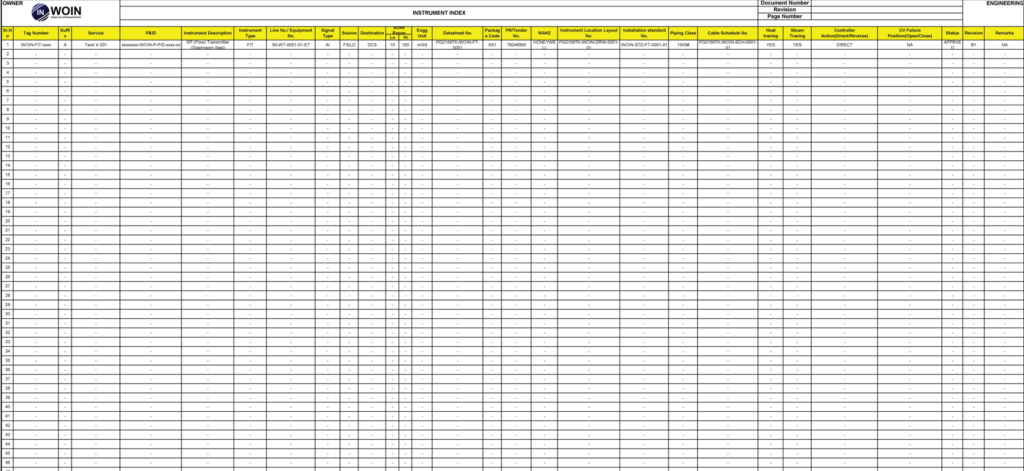The instrumentation index is a very important document for any instrument engineer. You can also download the Free industrial standard instrumentation index sheet.
The most common skills mentioned in every instrumentation design engineer job vacancy include the preparation of the Instrumentation Index and IO list documents.
I will share information on the IO list in my separate article so I stay connected.
At the end of the article, I will also share an example instrument index format that I used for my projects so you can directly download it for your reference.
Introduction
The instrument index gives overall information about all the instruments that are used in the plant or any production unit.
If you are new in the plant as an instrument engineer and you have to take a look at what the instruments are and where I will find all the details about specific instruments then you just need to see the instrumentation index.
The instrumentation index is used as a navigation guide to how I will access more details about these specific instruments.
Preparation of INSTRUMENTATION INDEX
An Instrument Index is a type of document that contains a list of all the instruments used in the control system.
The format that I am using has a total of 28 columns and it may change according to project requirements and type. I will explain all the columns one by one.
1. Sr. No.: This column shows the simple serial number and the last serial number shows how many instruments are used or will be used in a specific plant/unit.
2. Tag No.: As you guess in tag no. the column you will find the tag no of the instrument as per your plant tag number philosophy.
3. Suffix: this column is not common in every instrumentation index but it is used for the classification of tags.
4. Service: The service column shows that this particular tag is used in which services like a storage tank, heat exchanger, etc.
5. P&ID: In P&ID Column you have to write P&ID drawing number where instrument is present.
6. Instrument Description: In the Instrument Description Column, you can find out what type of instrument.
7. Instrument Type: In the Instrument Type Column, you can find the short name of the instrument. like flow indicating transmitter is FIT, and TE means Temperature Element.
8. Line No./ Equipment No.: In this column, you have to write the standard pipeline number or Equipment No.
9. Signal type: In this column, you will find what type of signal it is like Analog Input, Analog Output, Digital Input, and Digital output.
10. Source/Destination: In these columns, you will find where this signal comes from and where it is going. like the field to DCS.
11. Scale Range: The scale range is divided into two columns High and low range of instruments.
12. Engineering Unit: In this column, you will find the engineering unit for measuring variables.
13. Datasheet No.: In this column, the datasheet number of the instrument, and you will easily find the datasheet for this specific instrument.
14. Make: In this column, you can find the make of this specific instrument like Honeywell, Emerson, etc
15. Locatioin and Installation no: by using this number you will find where this instrument is mounted and how it is installed. You can use the hookup drawing number as the installation number.
16. Cable Schedule: In this column, you will find the cable schedule number.
17. Other Specific requirements: Are heat tracing and steam tracing required for this instrument or not?
Type of the instrument: The type of instrument can be a flow transmitter, temperature transmitter, control valve, etc.
Manufacturer of the instrument: The manufacturer of the instrument will be in the future for spare management and procurement purposes
The model number of the instrument: The model of the instrument will be in the future for spare management and procurement purposes
Range of the instrument: The range of the instrument will be useful for commissioning the instrument
Process connection details to the instrument: Information about the process connection of the instrument will include the type of process connection, process connection size, etc.
Example of the Instrument Index:

EndNote
I hope these resources and Knowledge will become helpful to you in the future. And I continue to make this type of resource and knowledge-sharing posts on my website.
If you have any suggestions then feel free to ask in the comments and through email ID, if you want to write an article on the website, please contact us by this email id: contact@worldofinstrumentation.com
If you like this article, you can also like my previous article on How you can download free control valve sizing software by Fisher (Emerson).
And you can also follow our LinkedIn group which is specially made for sharing information related to Industrial Automation and Instrumentation.